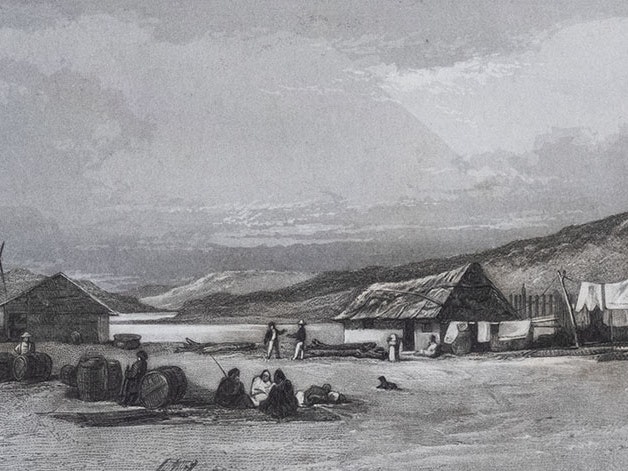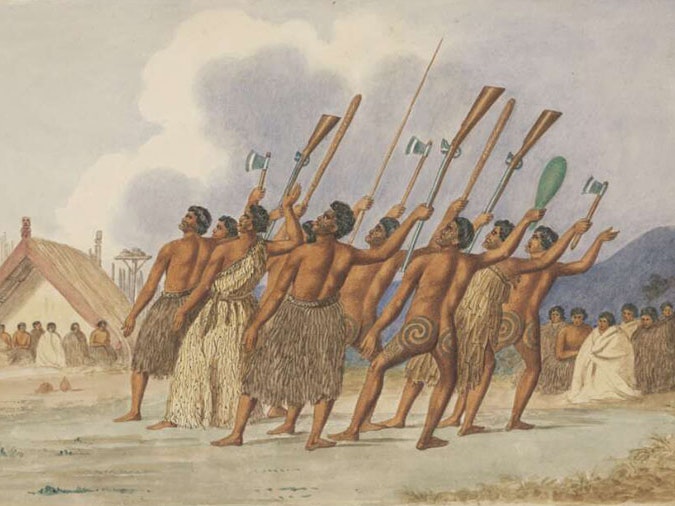
Māori and British trade
British and other visitors to New Zealand were quick to realise the business opportunities this land offered. Likewise, Māori saw that the visitors offered new trading possibilities.
Free museum entry for New Zealanders and people living in New Zealand
Open every day 10am-6pm
(except Christmas Day)
Free museum entry for New Zealanders and people living in New Zealand
The first visitors from Britain had no plans to settle in New Zealand. They were here on business: to explore, or to exploit this country’s natural resources.
Nau mai rā e te manuhiri tūārangi.
Welcome to the guest from afar.
In 1788, the British set up a convict colony in New South Wales, Australia, with its headquarters in Sydney. The voyage from Sydney to New Zealand was relatively short. Sydney traders could travel between a safe Australian base and the lesser known territory of New Zealand. British naval ships began to take spars for ships’ masts from New Zealand forests.
R. Havell & Son, The entrance of Port Jackson and part of the town of Sydney, New South Wales, 1823, engraving, aquatint. Rex Nan Kivell Collection, National Library of Australia (PIC Drawer 2261 #S1972)
With ships sailing to and fro, Māori also travelled overseas.
Te Pahi from the Bay of Islands, one of the first rangatira to visit Australia. In 1805–06, he spent three months in Sydney, and came back to New Zealand with new tools, seeds, and livestock. After that, a number of Māori headed across the Tasman to make contacts and expand their knowledge.
Watch a documentary about Te Pahi
Early visitors to this country needed to stay on good terms with Māori. They relied on Māori to guide them across this country’s rugged terrain and sometimes paid them to carry their goods.
They also depended on Māori for food supplies, and needed their permission – and protection – to live and work on their lands.
Augustus Earle, Distant view of the Bay of Islands, New Zealand, about 1827, watercolour. Rex Nan Kivell Collection, National Library of Australia (PIC Solander Box B6 #T108 NK12/70)
There was one kind of British visitor who planned to settle here permanently: the Christian missionary.
In 1814, Samuel Marsden, an agent for the Anglican Church Missionary Society, set up New Zealand’s first mission station in the Bay of Islands.
Marsden believed that if Māori became interested in British ways of life, they would naturally want to become Christians, so he offered training in British farming and gardening techniques. Some Māori were keen to learn the new skills.
Unlnown artist, The missionary settlement Rangihoua on the north side of the Bay of Islands, New Zealand, about 1832, oil on wood panel. Rex Nan Kivell Collection, National Library of Australia (PIC Screen 17 #T316 NK131)
Joseph Backler, Revd. Samuel Marsden, first missionary to New Zealand, between 1832-1838, oil on canvas. Alexander Turnbull Library, Wellington, New Zealand (G-620)
***
This content was originally written for the Treaty2U website in partnership with National Library of New Zealand Te Puna Mātauranga o Aotearoa and Archives New Zealand Te Rua Mahara o Te Kāwanatanga in 2008, and reviewed in 2020.

British and other visitors to New Zealand were quick to realise the business opportunities this land offered. Likewise, Māori saw that the visitors offered new trading possibilities.

One item the Pākehā visitors brought caused more upheaval than any other – the musket. At the start of the 19th century, these guns were the norm on European battlefields.

From 1814, Christian missionaries from Britain began building up friendly relationships with Māori. Mutual trust grew, and eventually this helped the British government gain influence here.